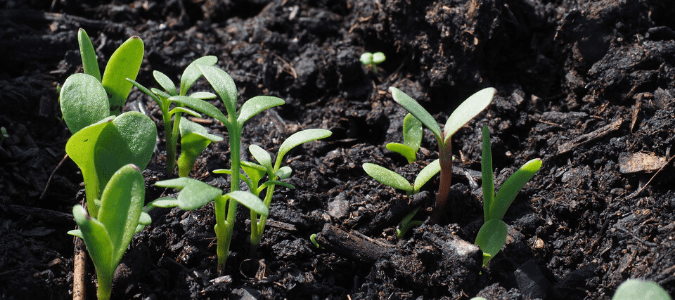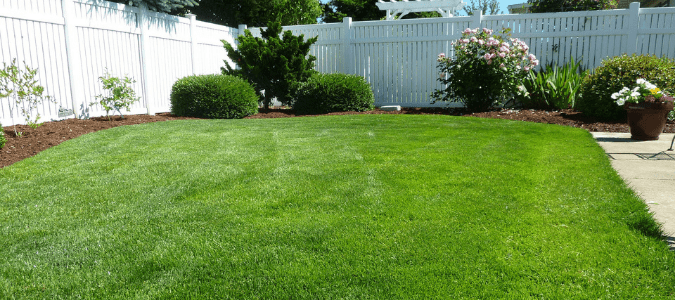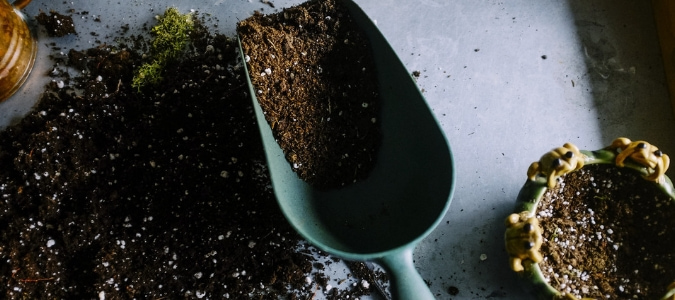People spend a good deal of time and, often, money creating a landscape that adds beauty and value to their home. From preparing the soil to planting to aftercare, it can be a lot of work. The last thing you want is for all the effort to end up with plants and shrubs that aren’t thriving in their environment. A big way to ensure that your landscaping is living its best life is by adding mulch.
Why mulch? It gives your flower beds and other landscaping a finished look. It also has a number of benefits for the plants themselves. Mulch keeps moisture in the soil and even helps break up any clay. This allows the moisture to dig deep and keep the soil cool in the heat. It also helps resist frost issues in the winter, gives the soil nutrients as the mulch decomposes and blocks weeds from popping up.
You are probably familiar with wood or bark mulch, which is very common. If you want to use something you already have, you could use grass clippings you collect after mowing and use it as mulch. But there is another substance that is even better for your landscaping and for the environment: compost.
Compost Facts
What is compost? Compost consists of decomposing plant parts such as leaves and food waste plus other recyclable organic materials such as paper and shredded newspaper. The result is often called “black gold” by gardeners. You collect these components in a container, outside in a partially shaded area that isn’t accessible to pets or wildlife. Look for a container that will drain well and that holds about 3 feet of compost, both in depth and width.
About every week or so, you will need to turn the composting materials with a shovel. This is basically just stirring it to ensure it breaks down correctly. If you aren’t getting a lot of rain in your area, you will also need to water the compost pile occasionally. This will ensure it has the proper consistency to use in your landscaping and garden. It can take many months, between three and twelve, depending on your climate. Generally, once the compost looks brown and crumbly, smells earthy and no longer contains any large pieces of material, it’s ready. A lawn care specialist would be happy to answer any questions you might have about using compost on your flower beds and other landscaping.
Benefits of Compost
Compost combines some of the benefits of mulch and of grass clippings. It retains moisture, blocks the growth of weeds and helps to regulate temperature. It is cheaper than buying bags of various types of mulch, making it a popular choice for frugal gardeners.
However, unlike wood mulch, which keeps nutrients in the soil, compost actually adds nutrients as well. When it rains or you water the landscaping, the water runs through the layer of compost and pushes nutrients and carbon deep into the soil. It also increases microbial activity in the soil and holds on to more water than other mulches, which saves you a bit on the water bill. Compost works extremely well as an organic fertilizer and can help thwart soil erosion.
Not only is compost great for the soil, but it is also wonderful for plants. Studies have shown that using compost as mulch reduces pest and disease damage and speeds the growth of the plants. Flowers and vegetables grow larger when nestled in compost, and their stems and leaves also benefit in their growth. This increased growth is a result of compost’s neutralization of some toxins and balancing of pH in addition to the benefits listed above.
Top Dressing Lawn With Compost
Top dressing is just what it sounds like: placing one material on top of another. Adding a layer of compost to the soil around your lawn and other landscaping will improve your soil.
Adding compost as a top dressing as part of regular landscaping maintenance is the best way to ensure continued health and optimal growth of your plants. A lawn care specialist can create a maintenance schedule especially for your yard. This will give you great results without the worry of trying to find the time to take care of it all yourself.
Compost can be added to your landscaping any time that the ground is not frozen. That said, you will get the best results if you add a layer after aerating the soil. Adding compost at the same time you are seeding your lawn is also beneficial. This is because it will improve both germination and the retention of moisture.
It is important to use the right amount of compost. An overall depth of one-quarter of an inch to one-half of an inch is ideal. For context, to get that depth, you would need about one cubic foot of compost for every 25 square feet of planting space. Most commercially sold bags of compost are about 1 cubic foot. For the most economical purchase, look into purchasing compost in bulk if you are going to need more than 10 bags’ worth. Bulk compost is usually sold by the cubic yard, which is 27 cubic feet each.
It is also important to use compost at the right time of year. If you use compost when it is too hot outside, it can end up burning the lawn and causing damage. You can add compost to your yard in spring or in the fall, but avoid applying compost in the summer.
If you are buying compost instead of creating your own, look for a type that has been created by the hot composting process. The method, which hits 140 degrees during the natural process, ensures weed seeds and any pathogens from the material used to make the compost have been neutralized. Most types sold commercially meet this standard. If you are compiling your own batch, use a soil thermometer while it is still “cooking” to check for the proper temperature.
Once you have planted with your compost, give it a good look to ensure there are no gaps and that the depth is consistent. Then water the area to help everything get settled. A professional can set up a lawn care schedule to ensure your landscaping has the right amount of compost and water throughout the year.
Too Much Compost on Lawn
Many homeowners wonder about how much compost they need. You want to have enough compost, but be careful to not pile it on. Anything deeper than one-half of an inch can cause problems of its own. Compost offers your landscaping a variety of beneficial nutrients but you can get too much of a good thing. A high dose of nutrients can damage and even kill some plants.
What has gone into the compost pile makes a difference as well. If, for instance, whoever made it uses rotten hay, it could contain broad-leaf herbicide. That hurts plant leaves. Also, some types of bacteria are not helpful for plant growth and can add organisms to your lawn that will cause diseases. Using a lawn care professional to add compost and maintain your lawn will ensure that you have the proper type of compost and the right amount for your area.
If you think you might have used too much compost and want to get your lawn back on the right track, the first step is to test your soil. You will want to look for things like pH, organic matter, phosphorus, potassium, soluble salts, calcium, magnesium, sodium and ammonium.
Soils with a pH below 6 are too acidic, and using agricultural lime can help repair that. The soil test should also have instructions for how much lime is needed to adjust the soil based on the pH reading.
Most soil that has been adversely affected by too much compost will have a pH above 7, meaning it isn’t acidic enough. Making the soil more basic by adding acidic qualities isn’t easy, however there are a few things to try.
First, stop adding compost. Piling it on your lawn will only compound the problems. Adding a sulfur product to the soil to bring the pH number down, as can adding such a product to the water you use to irrigate. If you are concerned about the pH in a smaller space like a flower bed, you might be able to just take away some of the compost and spread it around over a bigger space. If you need to remove salts from your lawn, flood the soil a few times a year, especially in any spots that don’t get the benefits of rainwater.
Ask a lawn care professional which product they recommend, or even better, have them handle the process themselves. They are experts at making sure your lawn is healthy.
ABC Can Ensure Your Lawn Has the Nutrients It Needs
Figuring out the best lawn care schedule can be tricky. Instead of trying to do it yourself, contact ABC Home & Commercial Services. Our professionals can handle all the work, so all you have to do is enjoy your time outside.



